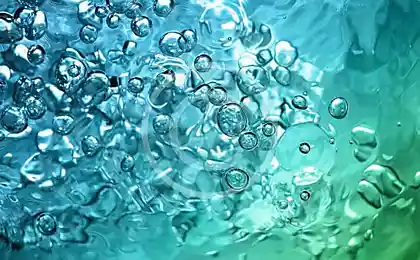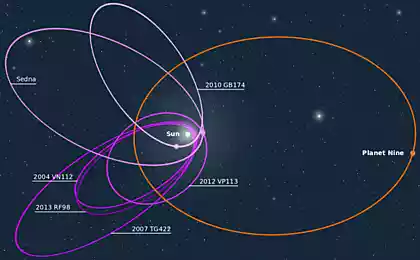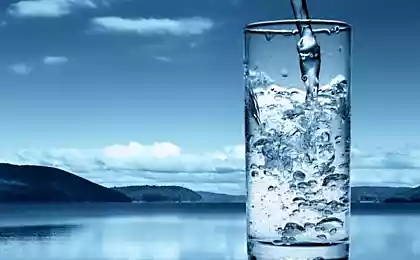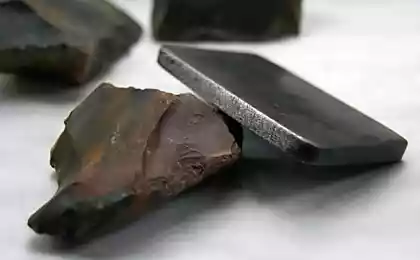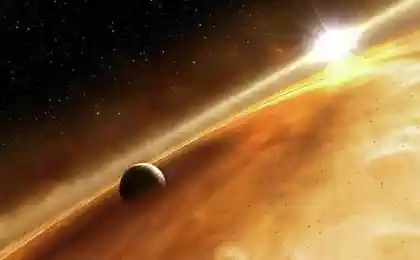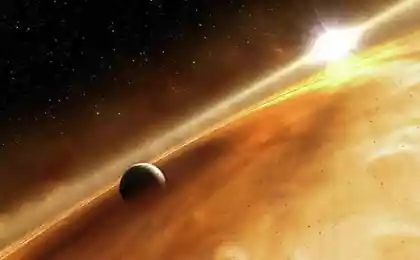536
5 celestial objects with water
Interested in space people very happy last post by NASA that on the surface of Mars is liquid water.
Of course, this discovery can greatly affect the idea of possible life on Mars, and it is the first confirmation of long-existing suspicions about what the red planet occur seasonal streams of liquid water.
But there's a catch — the Martian water flows is absolutely incomparable with the amount of liquid water on Earth and even on other celestial bodies of the Solar system.
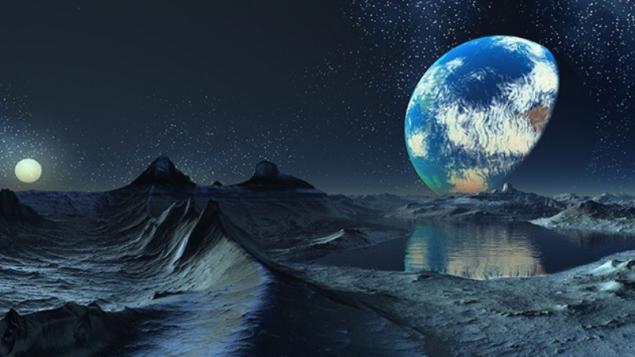
Discovered by NASA, the threads are actually more like "thin layers of moist soil," said Alfred Mak Yuen, one of the authors of a new study on the discovery of water on Mars. NASA rightly focuses on the suitability of Mars for habitation, because it is the closest planet to us, which in the past could have life. But in the Solar system there are other heavenly bodies, it is theoretically suitable for life even though they are much farther away from us.
Huge located under the surface layer of the oceans, filled with liquid substance that is likely to exist on many objects in the Solar system, so Mars would have to move. This is not the most rich in moisture world in outer space.
Here are a few other celestial objects that have received less attention, but they may water more than on Mars.
1. Enceladus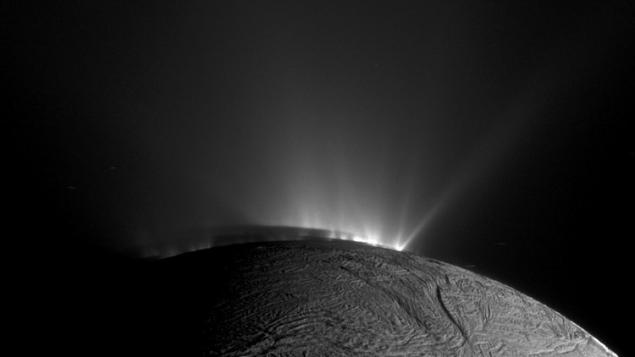
Passed in 2014 by the probe "Cassini" image coming out of the jets on the South pole of Enceladus
Earlier this year, the spacecraft Cassini has confirmed that on Saturn's moon Enceladus under the icy shell is a huge ocean. It covers the entire surface of a small satellite, and the cracks at its South pole provide an opportunity for the emission of jets of water ice into space.
Cassini may be able even to "try" the water from these streams before completing his mission, which is scheduled for 2017 year, as on 28 October, the probe will be held in the vicinity of Enceladus is 48 km from the moon's surface.
Thanks to this flight, scientists will try to establish the exact composition of the water in the ocean, as well as to draw conclusions about the suitability of the satellite for the existence of life.
2. Ganymede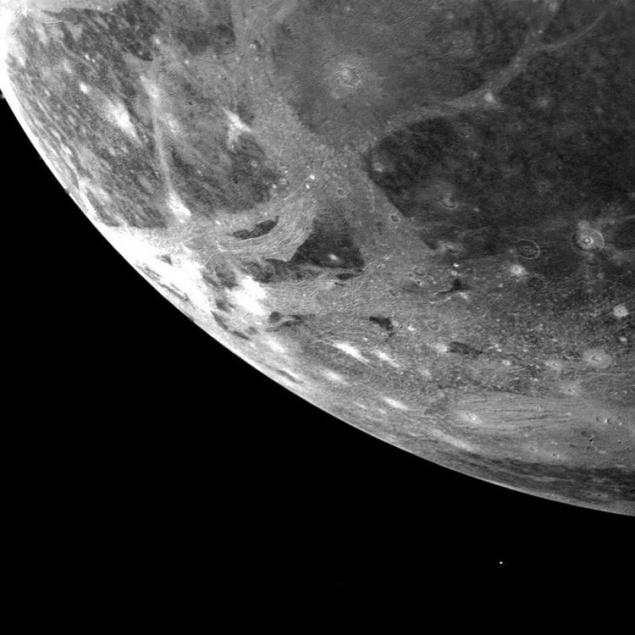
The largest moon of Jupiter Ganymede
There are many reasons to believe that on Jupiter's moon Ganymede has a deep and salty ocean that is located under the surface shell in which life could exist. NASA data show that the depth of the ocean is about 100 km — much higher than the depths of the oceans on Earth.
Scientists using the Hubble space telescope, also found that some of this water may reach the surface of Ganymede through the cracks in the icy shell. One of the leaders of scientific missions NASA's John Grunsfeld said:
"Deep ocean under the icy crust of Ganymede opens up even more amazing possibilities for the existence of life beyond Earth".
3. Europe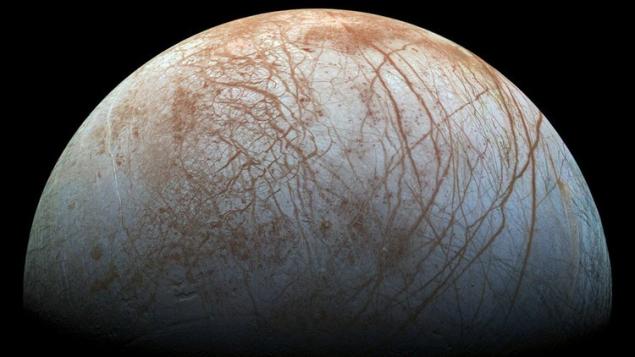
Another satellite of Jupiter, called Europe also may have a huge hidden under the superficial shell of the ocean.
Salt because he probably goes to the moon's surface, where the sunlight forms a distinct dark bands, visible in the photos. However, the presence of liquid water is not the only requirement for the origin of life. In may, a specialist in the study of the planets Kevin Hand told Mashable:
"A habitable world should combine water with a defined chemical elements and energy to the education and development of organisms. Salt is a great indicator of water seepage through rocks and leaching from them necessary substances".
The possible presence of an ocean under the surface of Europa inspired the creators of the scientific film "Europe", based on (have a chance to be true) assumption about the presence of life in the water, peeking through the icy crust of this heavenly body.
4. Titan
Orange moon Titan hides behind two of Saturn's rings. One of the 62 moons of Saturn pimeta visible just above the rings
The largest Saturn's moon Titan also may have a huge very salty ocean under the crust. The probe "Cassini" found that this ocean is likely the same salty as the Dead sea on Earth.
Probably even more interesting is located under the Titanium shell of the ocean will be a sea of methane and other hydrocarbons located on the surface of the satellite, and is the only one in our Solar system celestial object other than Earth, the surface of which there are large areas with liquid.
5. Perhaps Pluto is also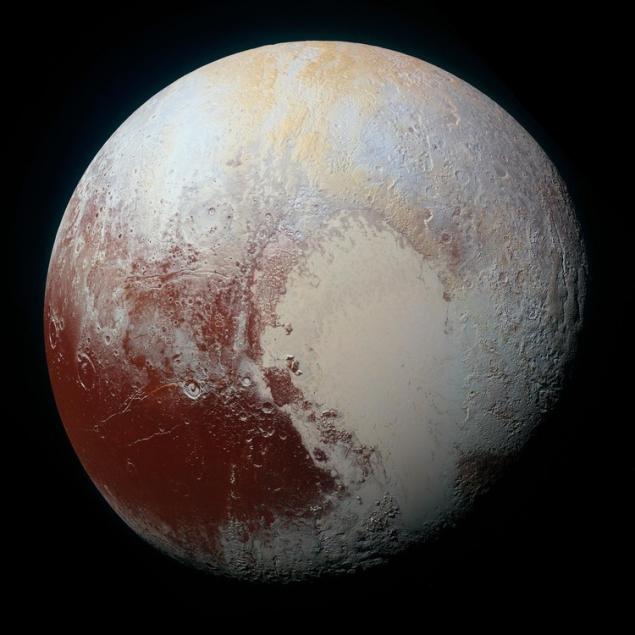
Pseudo-colour image of Pluto, obtained courtesy of NASA, the apparatus "New horizons" on 14 July 2015
Data from the device "New horizons" give scientists a tempting hint of the existence of an ocean beneath the icy crust of Pluto.
Surprisingly younger looking surface of Pluto has led some scientists to propose the hypothesis that this dwarf planet is probably located underground ocean, which causes geological activity. This activity arose the mountains of water ice height with the Rocky mountains as well, maybe the glaciers of nitrogen.
Scientists do not yet have direct evidence of the presence of the underground ocean, but this idea is often used in attempts to explain the strange formations visible on this tiny planet. One of the developers of "New horizons," William McKinnon presented in the statement of MIT wrote:"the Whole of the observable activity is consistent with the idea that Pluto has a massive rocky core surrounded by an icy shell. This increases the probability that under a thick layer of ice may be an ocean."published
P. S. And remember, just changing your mind — together we change the world! ©
Join us in Facebook , Vkontakte, Odnoklassniki
Source: insider.pro/EN/article/46891/
Of course, this discovery can greatly affect the idea of possible life on Mars, and it is the first confirmation of long-existing suspicions about what the red planet occur seasonal streams of liquid water.
But there's a catch — the Martian water flows is absolutely incomparable with the amount of liquid water on Earth and even on other celestial bodies of the Solar system.

Discovered by NASA, the threads are actually more like "thin layers of moist soil," said Alfred Mak Yuen, one of the authors of a new study on the discovery of water on Mars. NASA rightly focuses on the suitability of Mars for habitation, because it is the closest planet to us, which in the past could have life. But in the Solar system there are other heavenly bodies, it is theoretically suitable for life even though they are much farther away from us.
Huge located under the surface layer of the oceans, filled with liquid substance that is likely to exist on many objects in the Solar system, so Mars would have to move. This is not the most rich in moisture world in outer space.
Here are a few other celestial objects that have received less attention, but they may water more than on Mars.
1. Enceladus

Passed in 2014 by the probe "Cassini" image coming out of the jets on the South pole of Enceladus
Earlier this year, the spacecraft Cassini has confirmed that on Saturn's moon Enceladus under the icy shell is a huge ocean. It covers the entire surface of a small satellite, and the cracks at its South pole provide an opportunity for the emission of jets of water ice into space.
Cassini may be able even to "try" the water from these streams before completing his mission, which is scheduled for 2017 year, as on 28 October, the probe will be held in the vicinity of Enceladus is 48 km from the moon's surface.
Thanks to this flight, scientists will try to establish the exact composition of the water in the ocean, as well as to draw conclusions about the suitability of the satellite for the existence of life.
2. Ganymede

The largest moon of Jupiter Ganymede
There are many reasons to believe that on Jupiter's moon Ganymede has a deep and salty ocean that is located under the surface shell in which life could exist. NASA data show that the depth of the ocean is about 100 km — much higher than the depths of the oceans on Earth.
Scientists using the Hubble space telescope, also found that some of this water may reach the surface of Ganymede through the cracks in the icy shell. One of the leaders of scientific missions NASA's John Grunsfeld said:
"Deep ocean under the icy crust of Ganymede opens up even more amazing possibilities for the existence of life beyond Earth".
3. Europe

Another satellite of Jupiter, called Europe also may have a huge hidden under the superficial shell of the ocean.
Salt because he probably goes to the moon's surface, where the sunlight forms a distinct dark bands, visible in the photos. However, the presence of liquid water is not the only requirement for the origin of life. In may, a specialist in the study of the planets Kevin Hand told Mashable:
"A habitable world should combine water with a defined chemical elements and energy to the education and development of organisms. Salt is a great indicator of water seepage through rocks and leaching from them necessary substances".
The possible presence of an ocean under the surface of Europa inspired the creators of the scientific film "Europe", based on (have a chance to be true) assumption about the presence of life in the water, peeking through the icy crust of this heavenly body.
4. Titan

Orange moon Titan hides behind two of Saturn's rings. One of the 62 moons of Saturn pimeta visible just above the rings
The largest Saturn's moon Titan also may have a huge very salty ocean under the crust. The probe "Cassini" found that this ocean is likely the same salty as the Dead sea on Earth.
Probably even more interesting is located under the Titanium shell of the ocean will be a sea of methane and other hydrocarbons located on the surface of the satellite, and is the only one in our Solar system celestial object other than Earth, the surface of which there are large areas with liquid.
5. Perhaps Pluto is also

Pseudo-colour image of Pluto, obtained courtesy of NASA, the apparatus "New horizons" on 14 July 2015
Data from the device "New horizons" give scientists a tempting hint of the existence of an ocean beneath the icy crust of Pluto.
Surprisingly younger looking surface of Pluto has led some scientists to propose the hypothesis that this dwarf planet is probably located underground ocean, which causes geological activity. This activity arose the mountains of water ice height with the Rocky mountains as well, maybe the glaciers of nitrogen.
Scientists do not yet have direct evidence of the presence of the underground ocean, but this idea is often used in attempts to explain the strange formations visible on this tiny planet. One of the developers of "New horizons," William McKinnon presented in the statement of MIT wrote:"the Whole of the observable activity is consistent with the idea that Pluto has a massive rocky core surrounded by an icy shell. This increases the probability that under a thick layer of ice may be an ocean."published
P. S. And remember, just changing your mind — together we change the world! ©
Join us in Facebook , Vkontakte, Odnoklassniki
Source: insider.pro/EN/article/46891/
Creativity and restaurants: 10 of the most unusual institutions from around the world
Breast milk with pesticides or As fake research

